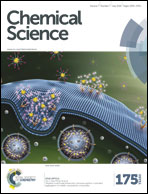Marcus-type driving force correlations reveal the mechanism of proton-coupled electron transfer for phenols and [Ru(bpy)3]3+ in water at low pH†
Abstract
Proton-coupled electron transfer (PCET) from tyrosine and other phenol derivatives in water is an important elementary reaction in chemistry and biology. We examined PCET between a series of phenol derivatives and photogenerated [Ru(bpy)3]3+ in low pH (≤4) water using the laser flash-quench technique. From an analysis of the kinetic data using a Marcus-type free energy relationship, we propose that our model system follows a stepwise electron transfer-proton transfer (ETPT) pathway with a pH independent rate constant at low pH in water. This is in contrast to the concerted or proton-first (PTET) mechanisms that often dominate at higher pH and/or with buffers as primary proton acceptors. The stepwise mechanism remains competitive despite a significant change in the pKa and redox potential of the phenols which leads to a span of rate constants from 1 × 105 to 2 × 109 M−1 s−1. These results support our previous studies which revealed separate mechanistic regions for PCET reactions and also assigned phenol oxidation by [Ru(bpy)3]3+ at low pH to a stepwise PCET mechanism.
![Graphical abstract: Marcus-type driving force correlations reveal the mechanism of proton-coupled electron transfer for phenols and [Ru(bpy)3]3+ in water at low pH](/en/Image/Get?imageInfo.ImageType=GA&imageInfo.ImageIdentifier.ManuscriptID=C6SC00597G&imageInfo.ImageIdentifier.Year=2016)

 Please wait while we load your content...
Please wait while we load your content...